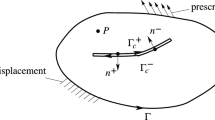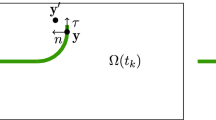Abstract
The extended finite element method (XFEM) is a numerical method for modeling discontinuities within a classical finite element framework. Based on the algorithm of XFEM, the major factors such as integral domain factor and mesh density which all influence the calculation accuracy of stress intensity factor (SIF) are discussed, and the proper parameters to calculate the SIF are given. The results from the case analysis demonstrate that the crack path is the most sensitive to the crack growth increment size, and the crack path is not mesh-sensitive. A reanalysis method for the XFEM has been introduced. The example presented shows that there is a significantly reduced computational cost for each iteration of crack growth achieved by using the reanalysis method and the reanalysis approach has increasing benefits as the mesh density increases or the value of crack growth increments size decreases.
Similar content being viewed by others
References
Wu Z J, Wong L N Y. Frictional crack initiation and propagation analysis using the numerical manifold method [J]. Computers and Geotechnics, 2012, 39: 38–53.
Branco R, Antunes F V. Finite element modelling and analysis of crack shape evolution in mode-I fatigue middle cracked tension specimens [J]. Engineering Fracture Mechanics, 2008, 75(10): 3020–3037.
Wu S, Fang S. Modeling cohesive cracks with meshless method [J]. International Journal of Damage Mechanics, 2009, 18(8): 721–737.
Wen P H, Aliabadi M H. Dual boundary element method for modelling curved crack paths [J]. International Journal of Fracture, 2012, 176(1): 127–133.
Belytschko T, Black T. Elastic crack growth in finite elements with minimal remeshing [J]. International Journal for Numerical Methods in Engineering, 1999, 45: 601–620.
Moës N, Dolbow J, Belytschko T. A finite element method for crack growth without remeshing [J]. International Journal for Numerical Methods in Engineering, 1999, 46(1): 131–150.
Réthoré J, Roux S, Hild F. Mixed-mode crack propagation using a hybrid analytical and extended finite element method [J]. Comptes Rendus Mecanique, 2010, 338: 121–126.
Gordeliy E, Peirce A. Coupling schemes for modeling hydraulic fracture propagation using the XFEM [J]. Computer Methods in Applied Mechanics and Engineering, 2013, 253: 305–322.
Zhu Q Z. On enrichment functions in the extended finite element method [J]. International Journal for Numerical Methods in Engineering, 2012, 91: 186–217.
Liu Z L, Menouillard T, Belytschko T. An XFEM/spectral element method for dynamic crack propagation [J]. International Journal of Fracture, 2011, 169(2): 183–198.
Fleming M, Chu Y A, Moran B, et al. Enriched element-free Galerkin methods for crack tip fields [J]. International Journal for Numerical Methods in Engineering, 1997, 40(8): 1483–1504.
Osher S, Sethian J A. Fronts propagating with curvature dependent speed: Algorithms based on Hamilton-Jacobi formulations [J]. Journal of Computational Physics, 1988, 79(1): 12–49.
Stolarska M, Chopp D L, Moës N, et al. Modelling crack growth by level sets in the extended finite element method [J]. International Journal for Numerical Methods in Engineering, 2001, 51: 943–960.
Sukumar N, Prèvost J H. Modeling quasi-static crack growth with the extended finite element method. Part I. Computer implementation [J]. International Journal of Solids and Structures, 2003, 40(26): 7513–7537.
Wu B, Li Z. Static reanalysis of structures with added degrees of freedom [J]. Communications in Numerical Methods in Engineering, 2006, 22: 269–281.
Pais M J, Yeralan S N, Davis T A, et al. An exact reanalysis algorithm using incremental Cholesky factorization and its application to crack growth modeling [J]. International Journal for Numerical Methods in Engineering, 2012, 91: 1358–1364.
Ventura G, Budyn E, Belytschko T. Vector level sets for description of propagating cracks in finite elements [J]. International Journal for Numerical Methods in Engineering, 2003, 58: 1571–1592.
Author information
Authors and Affiliations
Corresponding author
Additional information
Foundation item: the National Basic Research Program (973) of China (No. 2011CB013505) and the National Natural Science Foundation of China (No. 51279100)
Rights and permissions
About this article
Cite this article
Zheng, Ax., Luo, Xq. Numerical study of quasi-static crack growth problems based on extended finite element method. J. Shanghai Jiaotong Univ. (Sci.) 19, 736–746 (2014). https://doi.org/10.1007/s12204-014-1557-8
Received:
Published:
Issue Date:
DOI: https://doi.org/10.1007/s12204-014-1557-8




